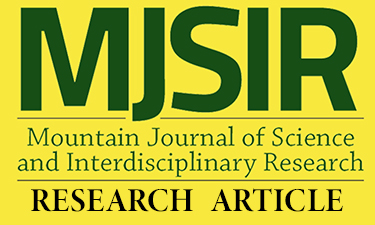Management Strategies Against Flea Beetle (Phyllotreta cruciferae Goeze) Infesting Pechay (Brassica rapa L.) in La Trinidad, Benguet
Main Article Content
Abstract
The study evaluated five management strategies against flea beetle infesting pechay varieties in terms of population, degree of crop injury, yield, and yield loss, determined the degree of efficacy and contribution of the treatments against flea beetle, and compared the return on investment (ROI) of the different management strategies employed. The study was conducted in La Trinidad, Benguet in 2021. Results revealed that while management strategies have a significant influence on the degree of injury by flea beetles (23% or slight in Black Behi and 30% or moderate in Cherokee), no positive interaction was traced in all major parameters used. Untreated plants showed even comparable injuries with those installed with physical barriers such as sticky traps, row covers, and sweeping. Insecticide spraying gave the greatest contribution as a single management strategy in both Black Behi and Cherokee varieties; however, netting gave the highest control contribution. For combination treatments, sweeping + netting gave the highest contribution of control but sweeping + row cover contributed the least to flea beetle pest control. Further, netting gave the highest ROI in Black Behi followed by sweeping + netting, while insecticide use resulted in the lowest gain. On the other hand, Cherokee had the highest ROI under sweeping + netting, closely followed by netting, while the lowest ROI was obtained from sweeping + row cover. Netting has contributed much in decreasing the insect population and degree of injury regardless of variety; however, the use of Black Behi without any applied treatments is still the most practical way in pechay production.
Article Details
References
Bockmann, E. (2022). Effects of insect net coverage in field vegetables on pests, diseases, natural enemies, and yield. Journal of Plant Diseases and Protection, 129, 1401–1415. https://link.springer.com/article/10.1007/s41348-022-00644-1
British Colombia Ministry of Agriculture. (2017). Environmental Protection and Pesticides. https://www2.gov.bc.ca/assets/gov/farming-naturalresources-and-industry/agriculture-and-seafood/ animal-and-crops/plant-health/environmentalprotection-and-pesticides.pdf
Demirel N. & Cranshaw, W. (2006). Relative Attraction of Color Traps to Western Black Flea Beetle, Phyllotreta ausilla Horn (Chrysomelidae: Coleoptera), on Spring Canola in Colorado. Pakistan Journal of Biological Sciences, 9(2): 277-280. https://scialert.net/fulltext/?doi=pjbs.2006.277.280
Faroden, Jr,. R.C. (2003). Effect of Density of Yellow Sticky Traps on the Population of Leaf miner (Liriomyza huidobrensis Blanchard) Associated with White Potato. Unpublished Thesis. Benguet State University, La Trinidad, Benguet.
Hazzard, R., Andersen, C., Van Driesche, R., & Mangan, F. (2003). Managing Flea Beetles on Brassica Greens. University of Massachusetts. https://newenglandvfc.org/sites/newenglandvfc.org/files/content/proceedings200/leafy_greens_ herbs/managing_flea_beatles_brassica_greens.pdf
Irmak, S. (2016). Impacts of Extreme Heat Stress and Increased Soil Temperature on Plant Growth and Development. Institute of Agriculture and Natural Resources CROPWATCH. https://cropwatch.unl.edu/2016/impacts-extreme-heatstress-and-increased-soil-temperature-plantgrowth-and-development
Jimenez, E.F., Mariano, J.S., Ferrer, M.J., & De Leon,V. (2000). Pechay Production Guide. http://bpi.da.gov.ph/bpi/images/Production_guide/pdf/pechay %20.pdf
Martin, T., Assogba-Komlan, E.F., Houndete, T., Hougard, J.M., & Chandre, F. (2006). Efficacy of Mosquito Netting for Sustainable Small Holders’ Cabbage Production in Africa. Journal of Economic Entomology, 99(2): 450–454. https://doi.org/10.1093/jee/99.2.450
Mayoori, K., & Mikunthan, G. (2009). Damage Pattern of Cabbage Flea Beetle, Phyllotreta cruciferae (Goeze) (Coleóptera: Chrysomelidae) and its Associated Hosts of Crops and Weeds. American-Eurasian Journal of Agricultural and Environmental Science, 6(3): 303-307. https://www.researchgate.net/publication/224861998_ Damage_Pattern_of_Cabbage_Flea_Beetle_Phyllotreta_cruciferae_GoezeColeoptera_Chrysomelidae_and_its_Associated_Hosts_of_Crops_and_Weeds
Michigan State University. (n.d.). How Pesticide Resistance Develops. https://www.canr.msu.edu/grapes/integrated_pest_management/howpesticide-resistance-develops
Ngumbi, E.N. (2020). How Changes In Weather Patterns Could Lead To More Insect Invasions. The Conversation. https://theconversation.com/how-changes-in-weather-patterns-could-lead-tomore-insect-invasions-131917
Pinoy Entrepreneur. (2010). Chinese Cabbage or Pechay Production. https://www.pinoy-entrepreneur.com/2010/04/23/chinese-cabbage-orpechay-production/
Traunfeld, J. (2021). Row Covers. University of Maryland Extension. https://extension.umd.edu/resource/row-covers
Vincent, C., Hallman, G., Panneton, B., & Lessard, F.F. (2003). Management of Agricultural Insects with Physical Control Methods. Annu. Rev. Entomol., 48: 261–281. https://bpb-us-w2.wpmucdn.com/u.osu.edu/dist/9/34289/files/2017/07/Management-of-Agricultural-Insects-with-Physical-Control-Methods-1ih3zur.pdf

